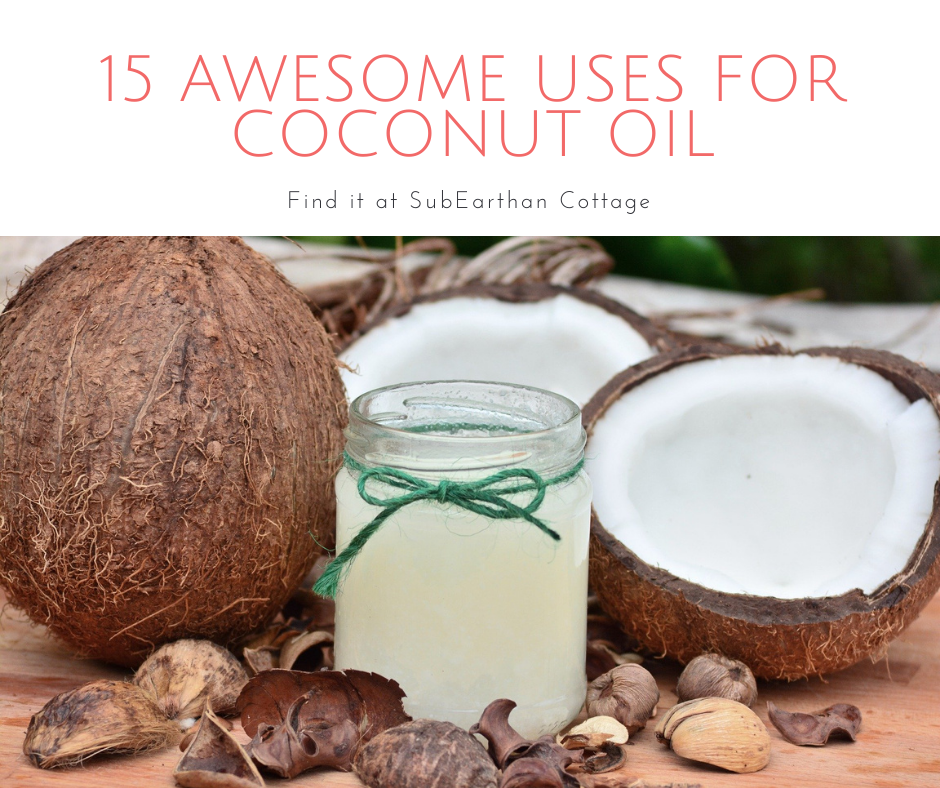
If I had to pick only one oil to keep around, it would be coconut oil. This versatile oil has many applications in and out of the kitchen. Here’s fifteen of my favorite uses for coconut oil.
Coconut Oil in the Kitchen
High Heat Cooking
Coconut oil is a stable oil, unlike olive oil. It doesn’t break down at high temperatures, making it great for frying, sautéing and other high-heat cooking applications.
Dairy and Animal Fat Substitute
Coconut oil is also a great butter substitute for those avoiding dairy. It also makes a great substitution for tallow or lard.
Cooking Popcorn
If you like cooking popcorn on the stove the “old-fashioned” way, coconut oil is the best. It adds a wonderful flavor to the popcorn, and holds up to the high temperature. My favorite way to eat popcorn is cooked in coconut oil and topped with salt and fresh cracked black pepper. It’s so simple and yet so yummy!
Season Cast Iron Skillets with Coconut Oil
I love my cast iron skillets. Whenever I need to re-season them, coconut oil is my go-to oil.
Coconut Oil for Cleaning
Natural Furniture Polish
The natural furniture polish recipe I use calls for olive oil, but coconut oil is a suitable substitute. It’s a little lighter and less greasy than olive oil, so it polishes out nicely. It also has a longer shelf-life, so there’s little worry about using it up before it goes rancid.
Stuck on Stickers
Rubbing a little coconut oil on sticker residue helps remove the residue without harming the surface underneath. I like to coat the sticker residue with oil and let it sit for a few minutes. Wipe in a circular motion with a rag or gentle scrubber until the residue is gone.
Coconut Oil for Hair
Protect and Treat Your Hair
I’ve seen it recommended to coat your hair in coconut oil and leave it in overnight before lightening your hair with bleach. While I personally haven’t tried that, since lightening my hair, I put a small amount of oil on my hair almost every day. I especially focus on drier or damaged areas. Since I started doing this, I’ve noticed a huge difference in my hair. It’s definitely stronger and smoother.
Deep Condition with Coconut Oil
Even if you haven’t tortured your hair with bleach, a deep conditioning treatment is good from time to time. Apply the oil to your hair and cover with a shower cap. Leave it in for a few hours or overnight and then wash out. A couple of drops of essential oil added to the oil makes the conditioning treatment even more luxurious.
Frizz Fighter
Rub a couple of drops of coconut oil in your hands and then smooth over the ends of your hair to keep frizz away.
Coconut Oil for Skin
Moisturize Your Skin
Coconut oil is great as a moisturizer. Start with a little and massage in to moisturize or to soothe dry, irritated skin. It even helps some eczema!
Diaper Ointment
Coconut oil provides a gentle, moisturizing barrier to soothe and protect babies’ bottoms. Unlike many commercial diaper creams, it is considered safe for cloth diapers. Do check with the manufacturer for their recommendations first, as using unapproved products can void any warranties.
Makeup Remover
A little coconut oil easily takes off eye makeup. I like to put it on a cotton square and gently swipe away makeup. As a bonus, it moisturizes your skin as it removes the makeup.
Shaving Cream
Shaving with coconut oil leaves my legs feeling soft, smooth and moisturized. I don’t even need to use lotion afterwards.
Handmade Soap
I use coconut oil in all of my soap recipes. It helps to create a firm bar that produces lots of fluffy lather.

Essential Oil Carrier
Coconut oil is my favorite carrier oil for essential oils. It’s not too heavy and absorbs nicely into the skin. If you use the refined oil, there’s no real coconut scent to compete with the essential oils.

Like this post? To make sure you never miss a future post, please sign up for my newsletter.
Through Friday, everything in my shop is 15% off. Shop now.








